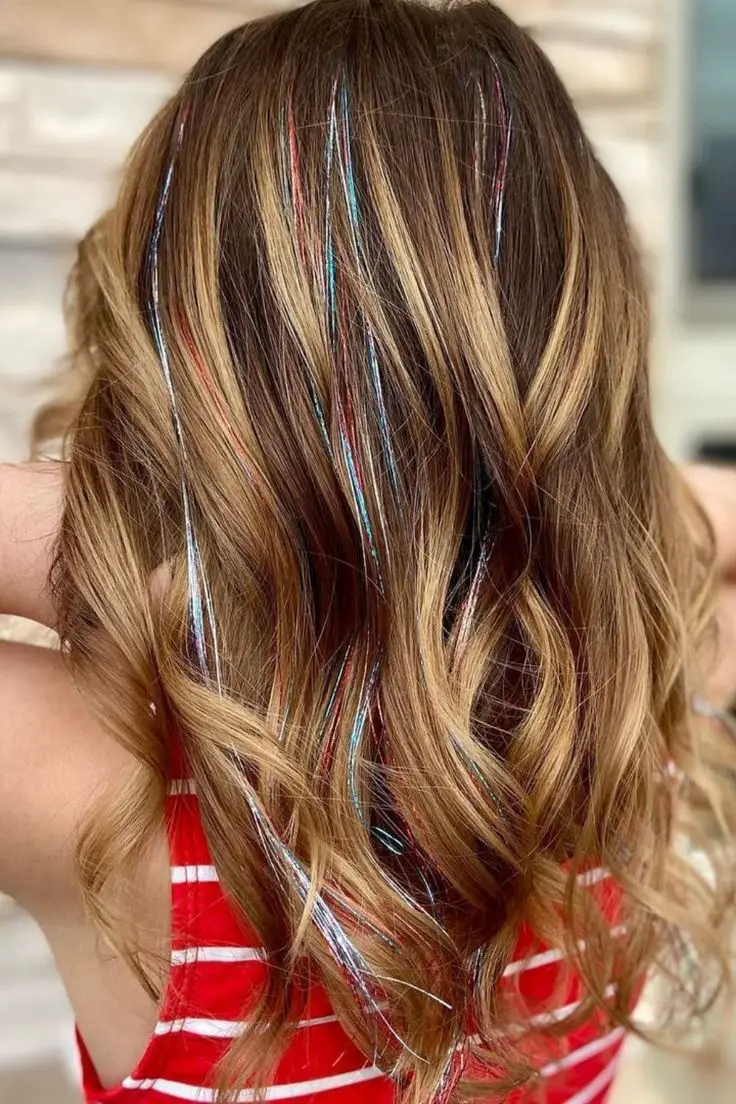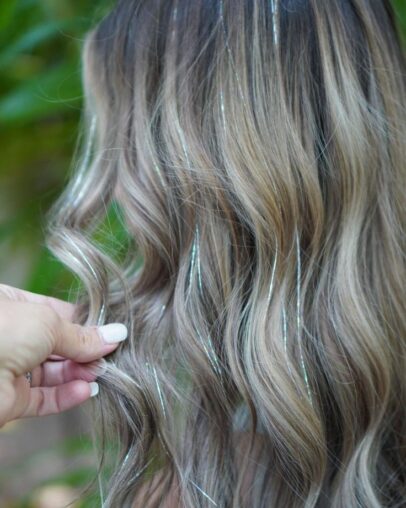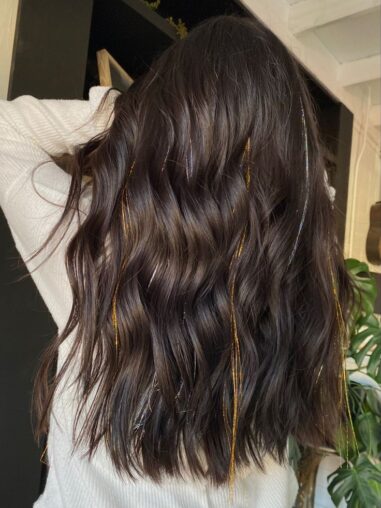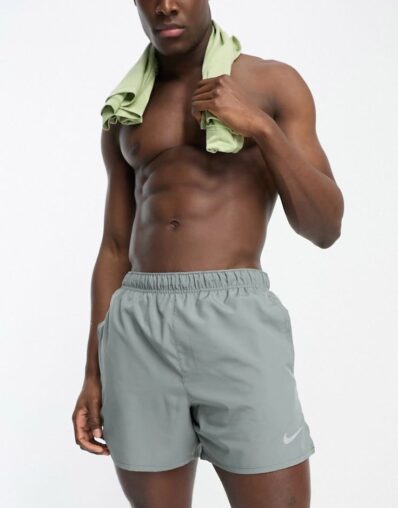
Are you someone who thrives on adding a touch of glamour to your look with tinsel hair extensions? Do you also have a penchant for swimming and wonder if you can indulge in both passions simultaneously?
In this comprehensive guide, we’ll not only answer this burning question but also delve into the myriad of factors that come into play when tinsels meet water. From the chemical composition of swimming pools to the natural salt content of oceans and post-swim hair care routines, we’ll explore it all. So, before you take the plunge, let’s ensure your tinsels continue to sparkle.
Why Swimming with Hair Tinsels is a Bad Idea

Physical Damage to the Tinsel:
Tinsel hair extensions are crafted from synthetic or metallic fibers, designed to exude shine and glamour. However, the introduction of water, particularly chlorinated water found in swimming pools, can have adverse effects on these fibers.
Prolonged exposure to water renders tinsels brittle, stripping them of their lustrous sheen and potentially making them look worn out or dull. In essence, swimming with tinsel hair extensions is akin to subjecting delicate jewelry to constant wear and tear, diminishing their visual appeal and durability.
Tangling & Matting
Wet hair, be it natural or extended with tinsels, undergoes a change in texture. This change increases the likelihood of hair tangling, and when coupled with intricate tinsels, the chances of knots and matting rise significantly.
Matting results in stubborn, tight knots that can be painful to untangle. Left unaddressed, they may necessitate a haircut or professional intervention. Combining wet hair with tinsels, therefore, sets the stage for a tangling nightmare.
Hair Damage
Tinsels are often attached close to the hair roots. When wet hair with tinsels is pulled or tugged, such as during combing, it places stress directly on these roots.
Over time, this stress can weaken hair follicles, rendering them more prone to damage or breakage. In essence, the very point where tinsels are anchored becomes a vulnerability, potentially leading to hair loss or thinning in those areas.
Uneven Drying
Hair retains moisture when wet, but different materials dry at different rates. Tinsels, owing to their composition, might retain moisture longer than your natural hair.
Consequently, even when your natural hair feels dry, the tinsels might remain wet, heavy, and uncomfortable against your scalp, akin to wearing damp clothing while the rest of your outfit is dry.
Adhesive Breakdown
Certain tinsels are secured with adhesives or glues that bond them to natural hair. Water, especially when combined with pool chemicals or ocean salt, can weaken this adhesive bond over time.
The result is tinsels slipping or prematurely falling out, akin to a piece of tape losing its stickiness after repeated exposure to moisture.
You Can Lose Them
Dynamic water environments, such as ocean waves or bustling public swimming pools, can physically disturb the placement of tinsels.
Weakened by adhesive breakdown, tinsels might detach and get lost in the water, much like losing a cherished piece of jewelry while swimming. Retrieving them is often challenging once they’re adrift.
Environmental Impact
Tinsels that detach and find their way into bodies of water pose a broader concern. These shiny fragments can become pollutants, potentially mistaken for food by aquatic animals or causing entanglements with harmful consequences.
Just as plastic waste threatens our oceans, foreign materials like tinsels can contribute to environmental degradation.
Costly Maintenance
Maintaining the integrity and appearance of tinsels post-swim may necessitate frequent visits to your hairstylist. Professionals may need to repair, replace, or reattach tinsels that have suffered damage or been lost due to water exposure.
This not only consumes time but also escalates the overall cost of maintaining the hairstyle, making it a more expensive endeavor.
Unpredictable Appearance

One of the key attractions of tinsel hair extensions is their ability to catch and reflect light, creating a dazzling sparkle. However, when wet or clumped together from swimming, their reflective properties can be compromised.
Instead of a consistent, radiant shine, you may end up with an unpredictable or patchy appearance, reminiscent of a sequined dress losing its sparkle when some sequins flip in the wrong direction.
Frequently Asked Questions
Can I swim with tinsel hair extensions?
Yes, it is physically possible to swim with tinsel hair extensions. However, it is not recommended. Swimming can expose the tinsels to potential damage and complications. Water, especially when chlorinated or salty, can affect the integrity of the tinsels, making them more prone to breakage or discoloration.
Additionally, the constant movement and flow of water can lead to tangling or matting, which can be challenging to manage after swimming. If you decide to swim with tinsels, it’s essential to take specific precautions to protect them and be prepared for potential post-swim maintenance.
How can I protect my tinsels if I decide to swim?
If you decide to swim with tinsel hair extensions, taking protective measures can help minimize potential harm:
Wear a Swim Cap
While not entirely waterproof, a swim cap can reduce the exposure of your tinsels to harmful chemicals and minimize the risk of tangling.
Rinse Before and After
Before entering the water, rinse your hair with fresh water. This can help prevent your hair from absorbing excessive chlorination or saltwater. After swimming, rinse again to remove any residual chemicals or salt.
Use a Protective Serum
Applying a hair serum or protective spray can create a barrier that reduces the impact of harmful agents in the water.
Avoid Brushing Wet Hair
Wait for your hair and tinsels to dry before attempting to comb or brush them. Wet hair is more fragile, and tugging can lead to breakage.
Secure Your Hair
Tie your hair in a loose bun or braid to reduce the chances of tangles and knots.
How do I handle tangles in my tinsels post-swimming?
If your tinsels become tangled after swimming, follow these steps to minimize damage:
Use a Detangling Spray
A detangling spray can provide slip, making it easier to untangle knots.
Start at the Tips
Begin detangling from the tips of your hair using a wide-toothed comb, gradually working your way up to the roots. This reduces stress on the hair and prevents pulling on the tinsels.
Be Gentle
Apply gentle pressure when detangling. If you encounter a stubborn knot, take your time working it out rather than pulling forcefully.
Seek Professional Help
If you’re unable to manage the tangles yourself or if they’re particularly severe, consider visiting a hairstylist. They can offer solutions to minimize breakage and restore your hair and tinsels to their former state.
How long should I wait after getting hair tinsels to swim?
After getting hair tinsels, it is recommended to wait at least 48 hours before swimming. This waiting period allows any adhesives used during the application process to set and cure properly.
Swimming too soon can weaken the bond between the tinsels and your natural hair, increasing the likelihood of the tinsels slipping out prematurely. Always consult with the professional who installed the tinsels for personalized advice and recommendations based on the specific materials and methods they used.
In many cases, they may advise against swimming with tinsels altogether to ensure their longevity and your hair’s health.
Are there eco-friendly tinsels that won’t harm the environment if they come off while swimming?
Yes, in response to growing environmental concerns, some brands and manufacturers have introduced eco-friendly hair tinsels. These tinsels are often crafted from biodegradable materials, which means they can break down naturally if they end up in the environment. However, it’s crucial to conduct thorough research and choose products that are genuinely sustainable.
When considering eco-friendly tinsels, inquire with suppliers or hairstylists about the materials used, their biodegradability, and any certifications the products may have.
While these options are more environmentally friendly, they can still pose tangling risks to aquatic life. Thus, it’s essential to exercise caution and do your best to avoid losing them in water bodies.
The Care and Maintenance of Tinsel Hair Extensions
Pre-Swim Preparation
Before taking the plunge, it’s essential to prepare your tinsel hair extensions for the aquatic adventure. Here are some steps to consider:
Brush Your Hair
Gently detangle your tinsels and natural hair with a wide-toothed comb or brush. Removing existing knots can help prevent further tangling in the water.
Apply a Protective Serum
Use a hair serum or protective spray to create a barrier that shields your tinsels from the effects of water and pool chemicals.
Tie Your Hair Securely
Consider tying your hair into a loose bun or braid to minimize movement and reduce the chances of tangles.
Post-Swim Care
After your aquatic escapade, it’s crucial to give your tinsels and natural hair some post-swim TLC:
Rinse Thoroughly
Rinse your hair with fresh water to remove any residual chlorine, salt, or pool chemicals. Ensure you rinse both your tinsels and natural hair.
Gently Pat Dry
Use a soft towel to gently pat your hair dry. Avoid vigorous rubbing, as this can lead to tangles and breakage.
Allow Natural Drying
Let your hair and tinsels air dry naturally to prevent excessive stress on wet hair, which can lead to damage.
Apply a Leave-In Conditioner
A leave-in conditioner can help restore moisture to your hair and tinsels, preventing dryness and brittleness.
Avoid Heat Styling
Refrain from using heat styling tools immediately after swimming, as they can further dehydrate your hair and tinsels.
Professional Maintenance
Regular visits to your hairstylist are essential to keep your tinsels looking their best. A professional can:
Inspect and Reattach Tinsels
Check for any loose or damaged tinsels and reattach them securely.
Trim Split Ends
Address any split ends or damage in your natural hair to maintain its overall health.
Provide Expert Advice
Hairstylists can offer tailored guidance on tinsel care and recommend products suited to your specific hair type and tinsel material.
Conclusion
While the allure of swimming with tinsel hair extensions may be tempting, it’s crucial to weigh the risks and rewards. Water exposure can compromise the integrity of your tinsels, potentially leading to damage, tangling, and even environmental concerns.
To enjoy both your sparkling tinsels and aquatic adventures, take precautions, follow recommended care routines, and consult with professionals for guidance. With the right approach, you can maintain the glamor of your tinsel hair extensions while making a splash in the water.












